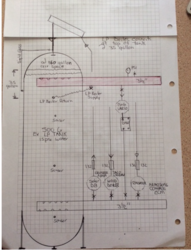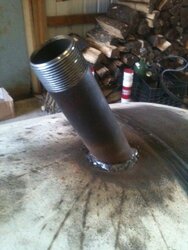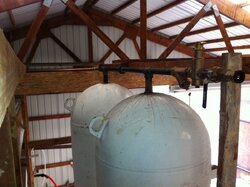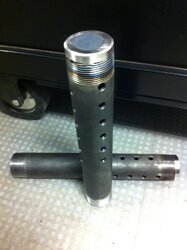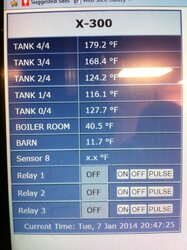Pat, I don't mean to be negative, but standing a 1775 pound tank on end, filled with 8340 pounds of water, is unsafe at best, and dangerous at worst. Highbeam mentioned the danger from earthquakes. If you think you're in an earthquake free region, guess again. I've been through three of them. One was in Stuttgart Germany in central Europe, one in Seattle (probably not that far from Highbeam) and one in Northern Virginia, not exactly earthquake prone regions. The unexpected happens. You wouldn't want to endanger your family if that precariously balanced massive weight comes crashing down for that or any other unforseen reason.
The risk of tragedy is way too great for the space saving or convenience you'd gain. If you're short on space, you could put the tank horizontally outdoors on an outside wall of your shop, spray foam it, and build a low, shed roofed structure over it. My 1000 gallon tank is insulated in an unheated space and works just fine.
At the least, have your local building inspector review your plans. If you can't because you know he'd turn them down, think about why he would. Proceeding on a construction project of this magnitude on the advice of of people on an internet site, even a fine one like this, people with the best of intentions but unknown qualifications in building construction, just doesn't get it. Advice from an engineer might be a good resource. I've built one home, and extensively remodeled others. While I hate to, I get all my own building, framing, plumbing and electrical work inspected, not only because it's the law, but because I'm not a professional and know just enough to be dangerous, That to me is what your project potentially appears to be with the weight involved. I could be wrong, but don't trust my judgement, trust a qualified professionals'. That amount of weight is no joke. The empty tank alone is enough of a misery to move it's so heavy.
Anyway I felt obligated to put in a warning. You don't want to be the guy on the 6:00 news people are shaking their heads about after a tree fell on your shop during a bad storm and knocked the tank over. Maybe the tank could land on your boiler when it was fired up. Things happen. Be safe, consider the risks, don't use sketchy building practices, and good luck whatever you do.
Mike


